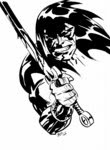Screengrab - "I no longer have thoughts, only memories"

When I was younger, I wanted to know exactly what a given work of art was about. I craved that certainty. It was as if I viewed art as a puzzle to be solved, as if when I had read a novel or watched a film, I could tick it off, having digested and understood it exactly, completely. I'm not quite sure when this need left me, but leave me it did. Nowadays I prefer art that defies easy interpretation, I love ambiguity and the kind of complexity and openness that encourages multiple readings. Great art should contain the scope for almost unlimited subjective judgements, I think (this is obviously distinct from the kind of work that confuses emptiness for ambiguity). My favourite film from last year, "Zodiac" is layered with possible meanings and ripe for several different angles of critical deconstruction, a quality that is one of its greatest strengths. There are directors incapable of anything other than this level of thematic transparence, Michaelangelo Antonioni prime amongst them.
"La Notte" (1961) is the second film in the trilogy beginning with "L'Aventurra" (1960) and ending with "L'Eclisse" (1962). It follows a married couple, Giovanni (Marcello Mastroianni) and Lidia (Jeanne Moreau) over the course of a day and a night in Milan as they cross the city, visiting friends and attending parties, and finally as they face their crumbling marriage. It has just been released on DVD in a beautiful transfer by Eureka's Masters of Cinema imprint (which is now truly revealing itself to be the closest thing in Europe to an equivalent to the Criterion Collection), which gave me my first ever chance to watch it. It is clearly a masterpiece, intent upon Antonioni's interest in the effect of modern society on the way we live and communicate with one another. As with each of his films, its themes and nuances will be better revealed and interrogated after several viewings, I suspect. What is evident after a first viewing is Antonioni's peerless style.
The beautiful monochrome photography (by Gianni di Venanzo, a frequent Fellini collaborator) captures these bored, alienated people in Antonioni's beautifully composed frames - dwarved by Milan's modern architecture (in one shot Moreau is barely visible walking in the lower left corner of the frame, the impassive, cold facade of a skyscraper dominating the rest of the screen) and isolated in the gardens of a party at a villa. An early sequence follows Moreau as she leaves the party thrown for her husband's book launch and strolls through Milan, moving from the crowded concrete and stone of the city centre and moving outwards into the run-down industrial suburbs. Antonioni always seems to know exactly where to place the camera and when to time a cut as she passes various characters - two men laughing hysterically, a baby crying in an abandoned lot, a group of youths gathered to watch a fight - and her impassive response to all of it asks us how we are to respond, what kind of meaning we are to divine from the kind of things we see daily in a modern city. In a sense, the sequence plays almost as the epitome of the worst in modern European art cinema. It is full of easy symbolism and a vague sense of ennui. But it is simultaneously layered with several possible thematic and narrative meanings. Moreau is fleeing her husband's recent betrayal and their problems. She is searching for some meaning, having just visited a terminally ill friend. Her reactions to her walk are as complex and unknowable as the responses of any real human being, whose life is full, at any instant, of several tiny secret realities, both mental and emotional, whose thoughts must be impossibly complex and fleeting. Much of the film is devoted to watching Moreau as she watches others, her implacable features always beautiful, never easily read.

This can be frustrating to the viewer accustomed to the easy emotional readings of much modern cinema - especially American cinema. Yet, if one surrenders to the particular rhythms and demands in Antonioni, then the rewards are great. Most obviously, there is that supreme cinematic style. Antonioni's use of the medium itself is what has made his work age so well - some of his shots feel incredibly modern, his subtle camera movements often sublime in their perfection. He also takes risks in his more daring compositions - a shot of Moreau in tight close-up, weeping beside the looming wall of a modern hospital building while Mastroianni comes into the frame in the background. Or the shot at the top of this post, when Mastroianni is lured into the hospital room of a nymphomaniac. Antonioni films her against a bare white wall, an almost abstract, theatrical setting pointing out her position within the film as both "real" character and symbol. Mastroianni walks across the frame, his black suit contrasted dazzlingly with that white, before she slides down his body in an embrace.
This shot reminded me of a similar shot by Vincente Minnelli in "Some Came Running" (1958). During the film's climax, set at a small town carnival, Minnelli stages a chase scene against a lurid, again almost abstract red background, his characters silhouetted figures against the visual violence of the colour. Its a breathtaking moment, and one that only a truly great stylist could conceive of or pull off. That description definitely applies to Minnelli, and to Antonioni too.
Labels: film



0 Comments:
Post a Comment
<< Home